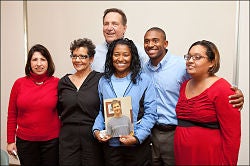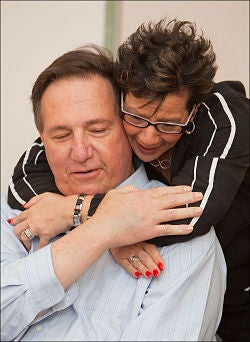ECU, PCMH provide gift of life via six-person kidney exchange
Doctors announced today what is believed to be the first successful six-person kidney exchange in the Carolinas.
Doctors from the Brody School of Medicine at East Carolina University and Eastern Urological Associates teamed to perform the surgeries Dec. 13 at Pitt County Memorial Hospital.
Dr. Robert Harland, professor and chief of immunology and transplantation at ECU and chief of transplant surgery at PCMH, said the procedures were successful and allowed three of the hospital’s wait list patients to receive living donor kidneys instead of potentially waiting years for a kidney from a deceased donor.
Facts about kidney transplantation and the transplant program at ECU and PCMH
–The kidney transplant program began at ECU and PCMH in 1981 when a 16-year-old Winterville resident received an organ from his brother.
–Kidney transplant surgery is one of the most common transplant operations in the United States. Doctors may recommend a transplant for patients who have end-stage renal disease. The most common causes of kidney failure include diabetes, hypertension and autoimmune disease.
–In a transplant, one donated kidney replaces the work previously done by the recipient’s pair of kidneys. The donated kidney may be from a living related donor, such as a parent, sibling, or child; a living unrelated donor, such as a friend, spouse or even a stranger; or a deceased donor who has recently died and who has no known chronic kidney disease.
–Living kidney donors usually live a normal life without complications with one remaining kidney.
–Once a matching donor is identified and a battery of tests and counseling are completed, plans are made for the actual operation. Urologists (surgeons who specialize in the urinary tract) and transplant surgeons work together with nephrologists (kidney specialists), nurses, social workers and others to ensure a smooth procedure.
–In the operating room, the donor is placed under general anesthesia before surgery. Many transplants are done using laparoscopic surgery, as was done in these cases. The surgeon makes three or four small cuts, usually no more than 1-inch each, in the belly and side. The surgeon will use tiny probes and a camera to do the surgery. Toward the end of the procedure, the surgeon will make one of the cuts larger (around 4 inches) to take out the kidney after dividing the artery and vein. With laparoscopic surgery, most people recover faster and feel less pain afterward.
–The healthy kidney is transported in cool salt water (saline) that preserves the organ until it is transplanted in the recipient.
–The patient receiving the kidney transplant is given general anesthesia before surgery. The transplant surgeon makes a cut in the lower belly area. He or she then places the new kidney inside the recipient’s lower belly. The surgeon connects the artery and vein of the new kidney to the artery and vein in the patient’s pelvis. Blood flows through the new kidney, which makes urine just like the recipient’s own kidneys did when they were healthy. The tube that carries urine (ureter) is then attached to the bladder. The surgeon then closes the incision. Usually, the recipients own kidneys are left in place.
–Kidney transplant surgery takes about three hours.
–Transplant recipients usually remain on anti-rejection medications for the rest of their lives. A transplant may add 10 to 15 years or more to their lifespan than they would have had on dialysis.
–Not all patients are candidates for a transplant. A transplant may not be done if a patient has certain infections; problems taking medications several times a day for the rest of his or her life; heart, lung or liver disease; other life-threatening diseases; a history of cancer; is an alcohol or drug abuser or has other risky lifestyle habits.
–PCMH and ECU have completed 82 kidney transplants so far in 2011.
Sources: National Library of Medicine, ECU, PCMH

Left to right, Barbara Kalinowski, wife of donor recipient Joseph Kalinowski, Darlene Williams, Joseph Kalinowski, Lynette Collins (holding photo of donor Timur Saltuklaroglu), James Collins, and Stephanie Richardson pose for a group photo Thursday. Photos by Cliff Hollis.
“This is the culmination of a process that has taken more than a year,” Harland said. “Each of these recipients had a willing donor who was not compatible with them. By finding better matches from the list of incompatible donors, we were able to complete three living donor transplants, which can be performed electively and have a longer lifespan than a transplant from a deceased donor.”
Other experts involved in the procedure included the following:
- Dr. Jonathan Taylor (Eastern Urological Associates)
- Dr. Greg Murphy (Eastern Urological Associates)
- Dr. Paul Bolin Jr. (ECU Physicians)
- Dr. Scott Kendrick (Eastern Nephrology Associates)
- Dr. Carl Haisch (ECU Physicians)
- Dr. Lorita Rebellato (ECU associate professor of pathology and laboratory medicine director of histocompatibility lab)
The donors and patients are the following:
- Timur Saltuklaroglu, 43, of Knoxville, Tenn., donated to Lynette Collins, 56, of Jamesville.
- Darlene Williams, 49 of Warrenton, donated to Joseph Kalinowski, 53, of Greenville.
- James Collins, 30, of Durham, donated to Stephanie Richardson, 31 of Hollister.<
/ul>
In these transplants, one donor did not have a compatible blood type for his recipient, and the two women who needed kidneys had antibodies that reacted with the donor tissue types, leading to a much higher risk of rejection. However, by exchanging kidneys, recipients could avoid these incompatibilities and receive optimal outcomes.
The donors met the recipients for the first time Thursday and all are doing well.
Stephanie Richardson, who had been on dialysis for more than two years, said she had become discouraged when she found out her mother, Darlene Williams, wasn’t a good match. Receiving a kidney from James Collins has been a blessing. “It’s one of the best things that ever happened to me,” she said.
Williams is thankful for James, too. “It’s a win-win. It didn’t matter a whole lot to me whether she got my kidney, just so she would get one. I was willing to give my kidney to whomever it would give a better life. I thank everyone for the opportunity and the gift that James has given me.”
James Collins first offered his kidney to his mother, Lynette, but they were not a good match. “I thought I was not going to be able to help. But then to find out that someone was going to get my kidney and, in turn, it would help my mother, I was all in and ready to do what was needed to make things go well.”
Lynnette Collins said she can’t find enough words to describe how special this Christmas is to her family. “As we’re celebrating the birth of Christ, we’re celebrating a re-birth within ourselves,” she said.
Lynnette Collins received her new kidney from Kalinowski’s friend and former colleague, Tim Saltuklaroglu. And Kalinowski received his kidney from Darlene Williams. “Because of the kindness of someone else to help, it’s just a wonderful gift,” Kalinowski said.

Joseph Kalinowski is hugged by Darlene Williams. He received her kidney.

James Collins stands behind his mother, Lynette.